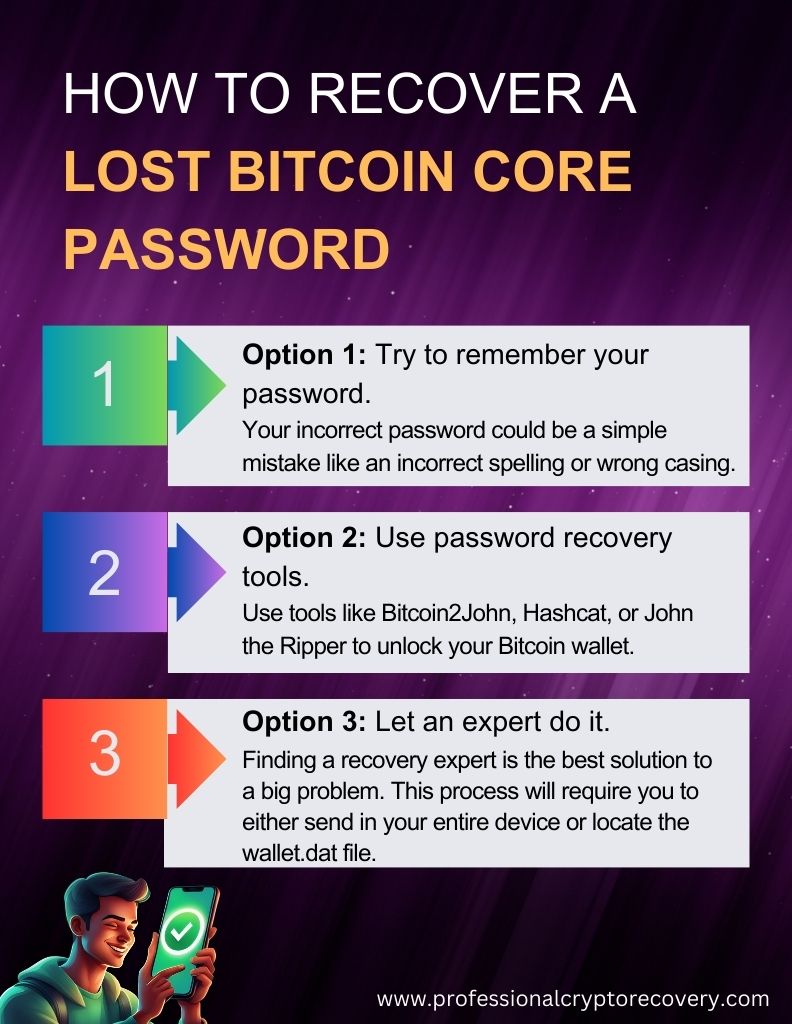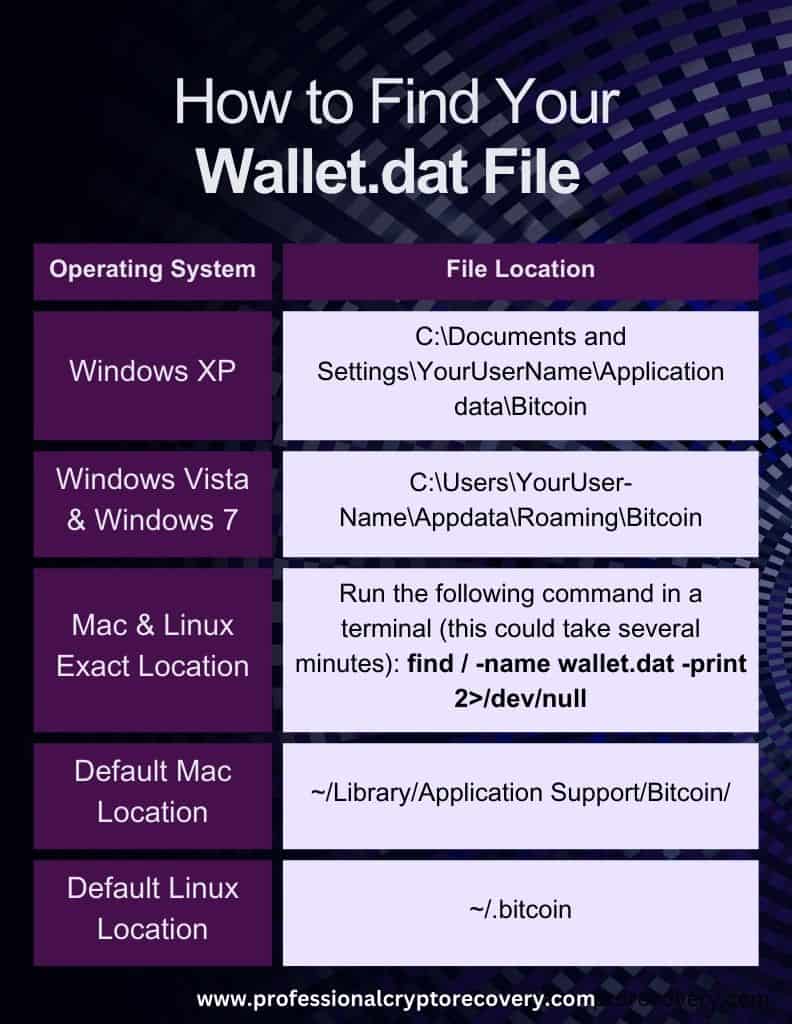Setting a Bitcoin Core wallet password protects your assets by ensuring no unauthorized person can access your funds. However, if you lose this password, you will find yourself on the wrong side of this defensive wall, unable to unlock your Bitcoin wallet and use your precious assets.
This is a difficult situation for anyone to be in, especially considering that Bitcoin is the most valuable cryptocurrency by far. So, your priority should be to recover the lost Bitcoin Core password.
How do you go about doing that?
This article touches on how the Bitcoin core wallet works and explores the various ways you can recover a lost password or passphrase.

How Bitcoin Core Works
Bitcoin Core is the wallet of choice among many Bitcoiners. This is down to two major reasons: it allows users to individually run their own full nodes and it’s one of the most secure non-custodial software wallets, developed and maintained by Bitcoin.org as the official client of the Bitcoin blockchain.
Bitcoin Core’s status as a blockchain client means it does not work like other crypto wallets. For one, it requires the user to download the entire history of the Bitcoin blockchain. This is because as a node client, it requires the complete record of Bitcoin transactions to run properly.
The most significant difference, however, is that it does not generate a seed/recovery phrase.
The recovery phrase is a mnemonic phrase, usually 12-24 words long, that cryptographically conceals a wallet’s public and private keys. This allows it to be used to restore or recover a wallet. Thus, most non-custodial wallets generate a seed phrase that they give to the user, who is tasked with securing it in case they ever need to recover their wallet.
Bitcoin core takes a different approach. The core wallet uses a special file, called wallet.dat, to store its private keys, public keys, transaction history, and other wallet information. The exact location of this file varies depending on your operating system. But generally, it is stored within the wallet applications data folder.

- Windows XP: C:\Documents and Settings\YourUserName\Application data\Bitcoin
- Windows Vista & Windows 7: C:\Users\YourUserName\Appdata\Roaming\Bitcoin
- Mac & Linux Exact Location: Run the following command in a terminal (this could take several minutes): find / -name wallet.dat -print 2>/dev/null
- Mac: ~/Library/Application Support/Bitcoin
- Linux: ~/.bitcoin
So, how do people secure their Bitcoin Core Wallets?
Securing Bitcoin Core Wallet
Private keys represent very sensitive data in the world of cryptocurrencies. Anyone with a wallet’s private keys can use them to access whatever crypto is associated with its address. Losing these keys might also mean losing access to your assets forever.
This makes it risky for the wallet.dat file to just be lying around unprotected. For one, it can be stolen by hackers. It can also be accidentally deleted or corrupted by malware.
So, many Bitcoin Core users choose to encrypt the file with a password or passphrase. This is to protect the private keys from unauthorized access. It ensures that if the file is ever stolen, the thieves will be unable to open it and see the private keys.
It is also important to note that private keys are used to sign transactions. Therefore, if they are encrypted in a wallet.dat file, you will be required to decrypt them (enter your password/passphrase) every time you want to transact bitcoin from your core wallet.
So, without this password or phrase, it is impossible to send bitcoin to another address. This means that a single mistake, like forgetting or having an incorrect bitcoin password, can result in losing access to your assets.
How to Recover a Lost Bitcoin Core Password
There are several ways you can go about recovering your lost Bitcoin core password.
Try to remember your password
This can be the most frustrating solution. However, it is also the simplest and most satisfying if it works. It is most likely to work if you have an idea of what your password is. You might even find that your incorrect bitcoin password is down to a small mistake; like incorrect spelling or wrong casing.
So, you want to pay close attention to the spelling, case, and special characters of your password. If none of that works, it’s time to make some password guesses.
First, you want to generate and write down ideas of what you think it was. Then, try them out one by one to see which one decrypts the file.
But if that still doesn’t work, don’t panic. You still have the next two options at your disposal.
Use password recovery tools
Your technical skills can save you where your memory has failed you. The internet is full of tools that you can use to crack the password to unlock your Bitcoin wallet. Even better, many of these are free and open-source. So, it will only cost you time to use them.
Some popular password recovery tools include:
- Bitcoin2John: This is a simple Python script that can be used to crack forgotten passwords. It is forked from Pywallet, a Python-based utility project with tools for interacting with Bitcoin wallets. Thus, Bitcoin2John is commonly used to recover the passwords and passphrases of Bitcoin Core wallets.
- Hashcat: This is a tool that takes various approaches to password cracking, from brute-force and dictionary attacks to mask and combinator attacks. However, it requires specialized hardware to leverage its full power.
- John the Ripper: This open-source password recovery tool supports Bitcoin’s BIP39 hash algorithms. Therefore, it can be used to recover the password of an encrypted wallet.dat file.
Note that these tools require a good amount of technical know-how. If you lack that, the next solution will probably suit you best.
Let an expert do it for you
If you want the best solution to a big problem, look for an expert. This statement is just as true for recovering a forgotten Bitcoin Core password as it is for anything else. In this case, you need to find yourself a good wallet recovery professional. Fortunately, working with one is straightforward.
They will only require you to send them the wallet.dat file, all potential password ideas, and a new address for sending your recovered bitcoins. Then, they will attempt to recover your password using their data recovery skills and some of the tools mentioned above.
If the recovery is successful, the recovery expert will move your assets to the new address you provided. After this, you might want to encrypt your wallet.dat with a word/phrase that you can easily remember.
Best Bitcoin Recovery Expert in Town
Professional Crypto Recovery has been helping Bitcoiners regain access to their crypto wallets for more than a decade. Having been in the IT industry for 21 years, we have the knowledge, skills, and experience needed to help you recover your lost/incorrect Bitcoin password.
We do it at a fraction of the time and the cost taken by other wallet recovery services in the market. Contact us now to get started.